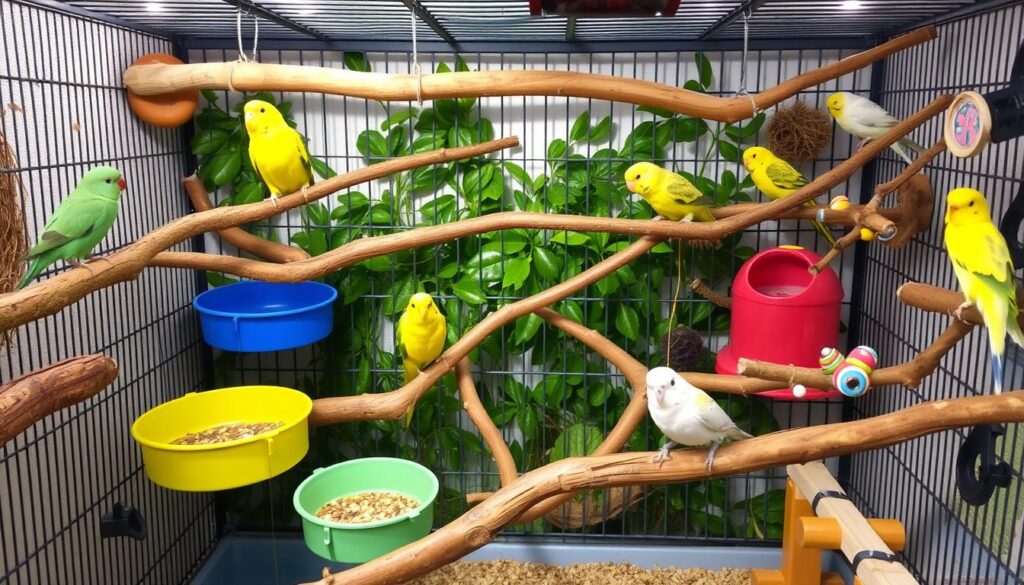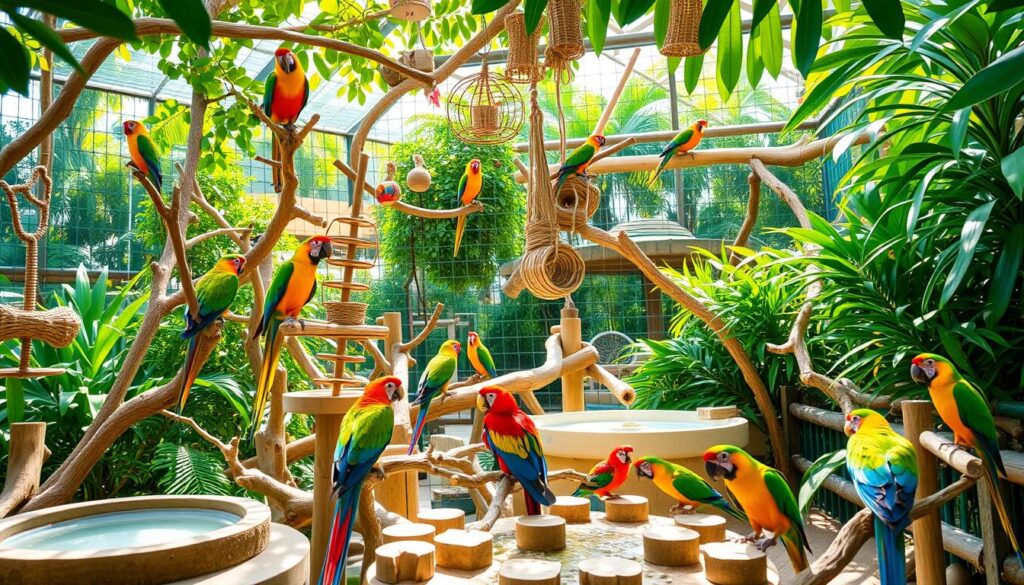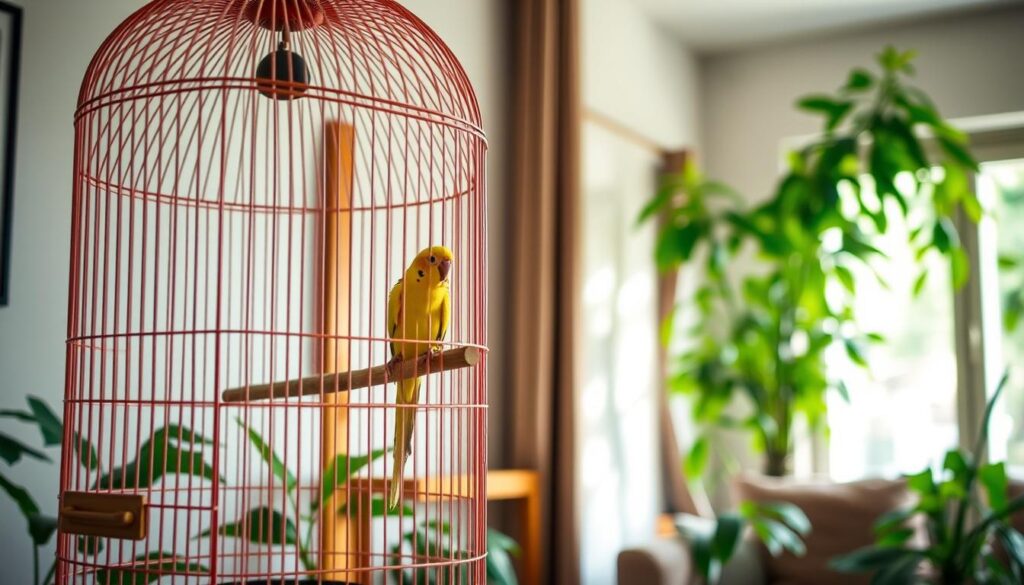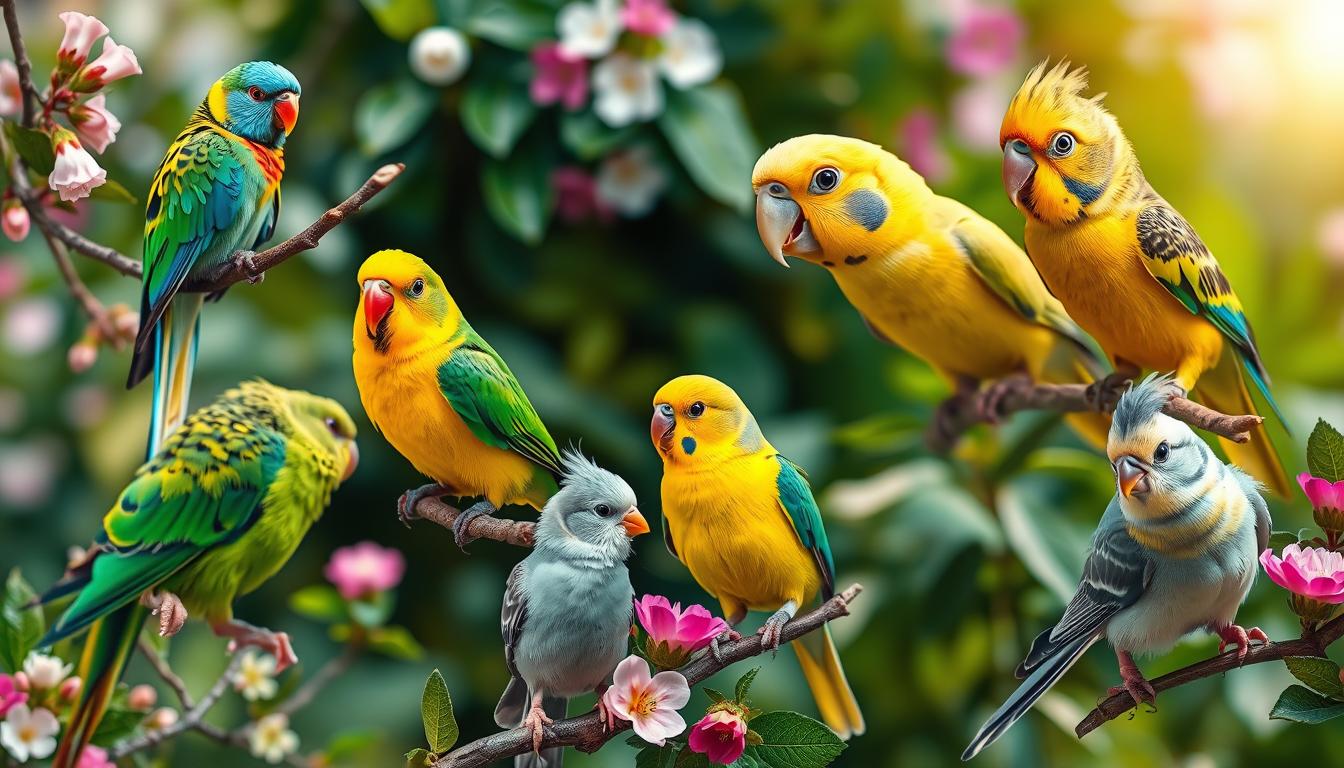Popular bird breeds for beginners. Are you captivated by the idea of welcoming a feathered friend into your home? Embarking on the journey of bird ownership can be an exciting and rewarding experience, but it’s essential to make an informed decision. In this comprehensive guide, we’ll explore the popular bird breeds that are well-suited for beginners, helping you discover the perfect companion that aligns with your lifestyle and preferences.
Whether you’re a first-time bird owner or simply looking to expand your avian family, this article will equip you with the knowledge to navigate the diverse world of pet birds. From temperament considerations to space requirements and lifespan, we’ll cover the key factors to help you find the most compatible bird breed for your unique needs.
Key Takeaways
- Explore the most popular bird breeds suitable for beginners
- Understand the essential factors to consider when selecting a pet bird
- Learn about the temperament, space requirements, and lifespan of different bird breeds
- Discover top-recommended beginner-friendly birds to start your avian adventure
- Gain insights into creating a nurturing environment for your new feathered friend
Understanding What Makes a Good Beginner Bird
When it comes to selecting a bird as a beginner, there are several key factors to consider that can make the experience more rewarding and enjoyable. Understanding these factors can help ensure you choose a bird that is well-suited to your lifestyle and skill level.
Temperament Considerations
One of the most important considerations for beginner-friendly birds is their temperament. Friendly, sociable, and easily trainable birds tend to make the best companions for novice owners. Look for breeds known for their calm demeanor, such as budgies, cockatiels, and lovebirds. These birds are often more tolerant of handling and interactions, making them ideal for building a strong bond with their owners.
Space Requirements
The amount of space a bird needs is another crucial factor. Beginner-friendly birds generally require larger cages or aviaries to accommodate their natural behaviors and exercise needs. For example, budgies and parakeets require a minimum cage size of 24 inches by 18 inches by 18 inches, while cockatiels need even more space. Ensure you have the necessary room to provide your feathered friend with a comfortable and enriching living environment.
Lifespan of Different Breeds
The lifespan of a bird is an important consideration for new owners. Many beginner-friendly birds, such as budgies and cockatiels, can live for 10-15 years with proper care. Lovebirds, on the other hand, have a slightly shorter lifespan of 8-12 years. Understanding the long-term commitment involved in bird ownership can help you make an informed decision that aligns with your lifestyle and ability to provide a stable, lifelong home.
| Breed | Temperament | Space Requirements | Lifespan |
|---|---|---|---|
| Budgie (Parakeet) | Friendly, sociable, and easily trainable | Minimum cage size of 24 inches by 18 inches by 18 inches | 10-15 years |
| Cockatiel | Calm, gentle, and affectionate | Larger cage or aviary | 10-15 years |
| Lovebird | Playful, energetic, and moderately trainable | Minimum cage size of 24 inches by 18 inches by 18 inches | 8-12 years |
“When choosing a bird as a beginner, it’s essential to consider their temperament, space requirements, and lifespan to ensure a positive and long-lasting experience.”
Top 5 Popular Bird Breeds to Start With
If you’re new to the world of bird ownership, it’s essential to understand the various breeds that make great companions for beginners. From the playful budgies to the affectionate cockatiels, each breed offers unique characteristics and care requirements. Let’s explore the top five popular bird breeds that are ideal for those new to avian companionship.
Budgerigar (Budgie)
The budgie, also known as the parakeet, is one of the most popular bird breeds for beginners. With their vibrant colors, friendly personalities, and relatively low maintenance, budgies are an excellent choice for first-time bird owners. These small, lively birds are known for their ability to learn tricks and mimic sounds, making them a delightful addition to any household.
Cockatiel
Cockatiels are another beloved bird breed for beginner owners. These medium-sized parrots are known for their distinctive crest and soothing calls. Cockatiels are generally gentle, affectionate, and relatively easy to care for, making them a popular pick among new bird enthusiasts.
Lovebird
Lovebirds are often considered a good option for beginners due to their small size and charming personalities. These vibrant, social birds thrive in pairs or small groups and can form strong bonds with their owners. While lovebirds require a bit more attention and socialization than some other breeds, they can be a rewarding choice for those willing to invest the time.
Parakeet
The parakeet, sometimes called the budgie, is a classic choice for beginner bird owners. These small, energetic birds are known for their vivid colors, playful nature, and relative ease of care. Parakeets are often a great option for those looking to introduce their family to the joys of bird ownership.
When choosing a bird breed, it’s essential to consider factors such as temperament, space requirements, and the level of care required. By researching and understanding the unique characteristics of each breed, you can select the perfect feathered companion to suit your lifestyle and preferences.
Choosing the Right Bird for Your Lifestyle
When selecting a bird as a new pet, it’s crucial to consider how well the breed aligns with your lifestyle. Different bird species have varying activity levels and social needs, so finding the right match can ensure a harmonious and fulfilling relationship.
Activity Level and Social Needs
Some birds, like parakeets and cockatiels, are highly active and social, requiring ample interaction and playtime to thrive. Others, such as lovebirds and parrotlets, may be more content with less constant attention but still need regular engagement. Understanding the energy levels and socialization requirements of prospective bird breeds is key to ensuring a good fit with your available time and energy.
Compatibility with Children and Other Pets
The compatibility of a bird with children and other pets in the household is another important factor to consider. Certain bird breeds, like the cockatiel, tend to be gentle and patient, making them well-suited for homes with children. However, more aggressive or high-strung species may not be the best choice if you have young kids or other furry companions. Researching the temperament and interactions of different birds can help you find the right fit for your family dynamic.
Time Commitment for Care
Caring for a bird requires a significant time investment, from daily interaction and cleaning to providing a stimulating environment. Some breeds, like budgies, may demand less hands-on attention than larger parrots. Evaluating your ability to commit the necessary time and resources to a bird’s well-being is crucial to ensuring a successful and enriching pet ownership experience.
By considering your lifestyle, activity levels, household dynamics, and available time, you can select a bird that will thrive and bring joy to your family. Matching the right breed to your unique situation is the key to a rewarding and long-lasting bird-human bond.
Setting Up Your Bird’s Home Environment
Creating a comfortable and enriching living space for your feathered friend is crucial for their overall health and well-being. When setting up your bird’s home, consider the following key factors to ensure a safe and stimulating environment.
Cage Size and Type
The size of your bird’s cage is directly related to their activity level and space requirements. As a general rule, the cage should be large enough for your bird to spread its wings comfortably and move around without restriction. Opt for a cage that is tall and wide, providing ample vertical and horizontal space for your bird to explore. The cage should also have ample perches of varying sizes and textures to encourage natural behaviors.
Essential Accessories and Toys
- Provide a variety of bird toys, such as ladders, swings, and foraging toys, to stimulate their natural curiosity and keep them mentally engaged.
- Include hiding spots, such as nest boxes or platforms, where your bird can retreat and feel secure.
- Incorporate natural elements like branches, ropes, and perches to mimic the bird’s natural environment and promote healthy behaviors.
- Ensure the cage is equipped with food and water dishes, as well as any necessary accessories like a grit tray or cuttlebone.
Location of the Cage
The placement of your bird’s cage is crucial for their well-being. Choose a location that is away from drafts, direct sunlight, and high-traffic areas. Avoid placing the cage near windows, doors, or appliances that may startle or stress your bird. Instead, opt for a quiet, low-traffic area of your home where your bird can feel safe and secure.

By considering these essential factors, you can create a comfortable and enriching home environment for your beloved bird, allowing them to thrive and enjoy a high quality of life.
Feeding Your New Bird: A Beginner’s Guide
Providing your feathered friend with a balanced and nutritious diet is crucial for their overall health and well-being. As a new bird owner, it’s essential to understand the different types of bird food, the importance of fresh fruits and vegetables, and the water requirements for your pet. By following this beginner’s guide, you can ensure your bird receives the proper bird diet and bird nutrition to thrive.
Types of Bird Food
The foundation of your bird’s bird feeding guide should be a high-quality commercial seed mix or pellet formula. These formulated foods are designed to provide your bird with the essential vitamins, minerals, and nutrients they need. Supplementing their diet with fresh, fresh food for birds such as fruits and vegetables can further enhance their overall bird nutrition.
Fresh Fruits and Vegetables
- Incorporate a variety of fresh, chopped fruits and vegetables into your bird’s diet, such as:
- Apples
- Carrots
- Spinach
- Sweet potatoes
- Berries
- Wash and prepare the produce properly to ensure it is clean and safe for your bird to consume.
- Avoid any foods that may be toxic to birds, such as avocado and onions.
Water Requirements
Providing your bird with a constant supply of clean, fresh water is essential for their hydration and overall health. Change the water daily and ensure the water bowl is positioned in a clean, accessible area of the cage.
By understanding the bird diet, bird nutrition, and proper bird feeding guide for your new feathered friend, you can ensure they receive the nourishment they need to thrive in their new home.
Basic Bird Care Tips for Beginners
Embarking on the journey of owning a pet bird can be an incredibly rewarding experience, but it also comes with essential responsibilities. As a beginner bird owner, it’s crucial to establish a solid bird care routine to ensure your feathered friend’s well-being. Let’s delve into the key aspects of daily care, grooming, health checks, and handling techniques that will help you provide the best possible life for your new avian companion.
Daily Care Routines
Maintaining a consistent bird care routine is the foundation of your bird’s overall health and happiness. This includes providing a balanced diet, offering clean, fresh water, and diligently cleaning the bird’s cage on a regular basis. Allocate dedicated time each day to interact with your bird, whether through playtime, training, or simply observing their natural behaviors.
Grooming and Health Checks
Regular bird grooming and health checks are essential for your feathered friend’s well-being. Trim your bird’s nails and wings, when necessary, to ensure their safety and prevent any potential hazards. Familiarize yourself with the signs of common bird illnesses and conduct regular physical examinations to catch any issues early on. Establishing a strong relationship with an avian veterinarian is highly recommended for timely and professional care.
Handling and Bonding Techniques
Proper bird handling techniques are crucial for both your safety and your bird’s comfort. Approach your bird calmly and confidently, and learn how to gently pick them up and hold them securely. Invest time in bonding with your bird through positive reinforcement, patience, and consistent interaction. This will help build trust and foster a strong, lifelong connection between you and your feathered companion.
By following these basic bird care tips, you’ll be well on your way to providing a safe, enriching, and loving environment for your new pet bird. Remember, every bird is unique, so be prepared to adapt your care routine to suit your bird’s individual needs and preferences.
Common Health Issues in Birds
As beloved pets, birds require attentive care to maintain their overall well-being. Recognizing the signs of illness in birds is crucial for providing prompt and effective treatment. From respiratory infections to feather disorders, bird health issues can vary widely. Regular check-ups with an avian veterinarian are essential for identifying and addressing any potential problems before they worsen.
Recognizing Signs of Illness
Vigilant bird owners should be on the lookout for a range of illness signs, including:
- Changes in appetite or drinking habits
- Lethargy or decreased activity levels
- Abnormal droppings or feather quality
- Respiratory distress, such as wheezing or gasping
- Unusual vocalizations or behavior
Importance of Regular Vet Check-Ups
Scheduling routine check-ups with an avian veterinarian is essential for maintaining your bird’s health. These professionals can detect potential issues early on and provide guidance on preventative care to keep your feathered friend thriving.
Preventative Care Solutions
Keeping your bird’s environment clean, providing a balanced diet, and addressing any behavioral or environmental stressors can go a long way in supporting their overall bird health. Regular grooming, nail trims, and wing trims can also contribute to your bird’s well-being.
By staying vigilant, partnering with an avian vet, and implementing preventative measures, you can help ensure your beloved bird enjoys a long, healthy life.
Creating an Enriching Environment
As a bird owner, providing an enriching environment is essential for your feathered friend’s well-being. Bird enrichment, bird socialization, and bird training are all crucial aspects of keeping your bird mentally stimulated and happy.
Social Interaction and Playtime
Birds are highly social creatures, and they thrive on regular interaction with their owners. Set aside time each day for social interaction and playtime. This can include activities such as supervised out-of-cage time, teaching simple tricks, and engaging in interactive games.
Learning and Training Activities
Incorporating learning and training activities into your bird’s routine can be an excellent way to provide mental stimulation. Teach your bird simple commands, such as “step up” or “come,” using positive reinforcement techniques. Introduce puzzle toys and foraging opportunities to challenge your bird’s problem-solving skills.
Keeping Your Bird Mentally Stimulated
To maintain your bird’s mental stimulation, rotate a variety of toys, perches, and environmental enrichment items in their cage. Encourage natural behaviors, such as shredding, climbing, and exploring, by providing appropriate materials and structures. Regular changes to the cage setup can also prevent boredom and promote a more enriching environment.
By prioritizing bird enrichment, bird socialization, and bird training, you can create a stimulating and fulfilling life for your feathered companion. Remember, a well-rounded and mentally stimulated bird is a happy and healthy one.

Understanding Bird Behavior
As a new bird owner, it’s crucial to understand the common habits and traits of your feathered friend. Each bird species has its unique behavioral patterns that can provide valuable insights into their needs and preferences. By observing and learning about your bird’s behavior, you can create a more enriching and engaging environment that caters to their natural instincts.
Common Habits and Traits
Birds are highly social creatures, and their behavior often reflects this. Cockatiels, for instance, are known for their sociable nature, while lovebirds are renowned for their affectionate behavior. Budgies, on the other hand, are admired for their ability to mimic sounds and interact with their human companions. Understanding these common habits and traits can help you better anticipate your bird’s needs and preferences.
Socialization and Play Behavior
Avian socialization and play behavior are crucial for a bird’s overall well-being. Birds thrive on social interaction and require opportunities for exploration, foraging, and play. Providing your bird with a variety of toys and activities can stimulate their natural curiosity and encourage healthy social behaviors. Observing how your bird interacts with their toys and other objects can provide valuable insights into their personality and preferences.
Recognizing Stress or Anxiety
Recognizing signs of stress or anxiety in your bird is essential for maintaining their overall health and well-being. Behavioral indicators such as feather plucking, excessive vocalization, or changes in activity levels may signal that your bird is experiencing stress. Being attuned to these signs can help you address any underlying issues promptly and ensure your bird’s comfort and happiness.
By understanding the common habits, socialization patterns, and stress indicators of birds, you can create a nurturing environment that supports your feathered friend’s natural behaviors and promotes their overall well-being. With patience and dedication, you can build a strong bond with your bird and enjoy the many joys of avian companionship.
Introducing Your Bird to Its New Home
Welcoming a new feathered friend into your home is an exciting moment, but it’s important to remember that the bird adjustment period can take time. By properly preparing for the new bird introduction and understanding the bird settling in process, you can help your new pet bird feel safe and comfortable in its new home.
Preparing for the First Days
Before your bird arrives, ensure that its cage is set up, stocked with fresh food and water, and placed in a quiet, low-traffic area of your home. Gradually introduce the bird to its new environment by allowing it to explore the cage at its own pace. Avoid handling the bird during this initial adjustment phase.
Handling the Initial Adjustment Phase
- Respect the bird’s need for privacy and allow it to acclimate to its surroundings at its own comfortable pace.
- Speak softly and avoid sudden movements or loud noises that may startle the bird.
- Offer your bird’s favorite treats through the cage bars to help build trust and positive associations.
Signs of Settling In
As your bird becomes more comfortable in its new home, you may notice signs of settling in, such as:
- Increased vocalization and activity levels
- Willingness to take treats from your hand
- Exploring the cage and interacting with toys
- Displaying natural behaviors like preening and wing-stretching
With patience and a gentle approach, your new pet bird will soon feel right at home, ready to embark on a rewarding journey of companionship and bonding.

How to Bond with Your Bird
Building a strong bond with your feathered companion is crucial for creating a harmonious and rewarding relationship. By employing bird bonding techniques and positive reinforcement strategies, you can foster a deep bird-owner relationship that benefits both you and your bird.
Techniques for Building Trust
The foundation of a strong bond lies in establishing trust. Approach your bird slowly and calmly, offering your hand for them to explore at their own pace. Avoid sudden movements or loud noises, which can startle and erode their confidence. Consistently engage in gentle bird trust building activities, such as talking softly, offering treats, and allowing them to perch on your finger.
Positive Reinforcement Strategies
- Utilize positive reinforcement for birds by rewarding desirable behaviors with their favorite treats or praise. This encourages them to repeat these actions and fosters a positive association with you.
- Gradually introduce new experiences, such as handling or training, while providing ample rewards. This helps your bird remain calm and confident during the process.
- Be patient and consistent in your approach, as building trust and rapport takes time and dedication.
Spending Quality Time Together
Regular, quality interactions are essential for strengthening the bird-owner relationship. Set aside dedicated time each day to engage with your bird through activities like talking, singing, or playing. Observe their behavior and learn to interpret their cues, responding accordingly to their needs and preferences.
| Bonding Activity | Benefits |
|---|---|
| Talking and Singing | Helps your bird feel safe and comfortable in your presence |
| Gentle Petting and Grooming | Reinforces trust and allows for physical bonding |
| Providing Toys and Puzzles | Stimulates your bird’s mind and encourages playful interaction |
By incorporating these bird bonding techniques, positive reinforcement strategies, and dedicated bird-owner relationship building, you can forge a deep and lasting connection with your feathered friend.
Conclusion: Your Journey with Your New Bird
Congratulations on taking the first step in welcoming a feathered friend into your life! Your journey as a new bird owner is sure to be filled with joy, laughter, and the occasional challenge, but the rewards of responsible pet ownership are immeasurable. As you embark on this adventure, remember the key points we’ve covered throughout this comprehensive guide.
Recap of Key Points
From understanding the unique temperaments, space requirements, and lifespans of different bird breeds, to setting up a safe and enriching home environment, you now have the essential knowledge to provide the best possible care for your new avian companion. Remember to tailor your approach to your bird’s individual needs, whether that means catering to their activity level, social requirements, or time commitments.
Encouragement for New Bird Owners
As a new bird owner, you may feel a mix of excitement and uncertainty, but take heart in the knowledge that your dedication and commitment will be rewarded tenfold. The bond you build with your feathered friend will be a source of endless joy and fulfillment. Embrace the learning process, cherish the moments of connection, and celebrate the unique personality of your beloved bird.
Continuing Education on Bird Care
Remember, the journey of bird ownership is a lifelong learning experience. Continually seek out opportunities to expand your knowledge and stay up-to-date on the latest advancements in avian care. Join bird enthusiast communities, attend local events, and consult with experienced veterinarians to ensure you provide the best possible quality of life for your winged companion.





